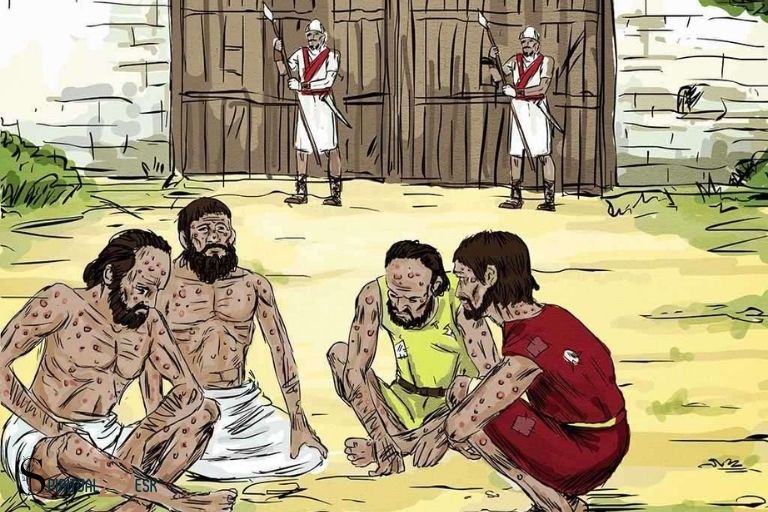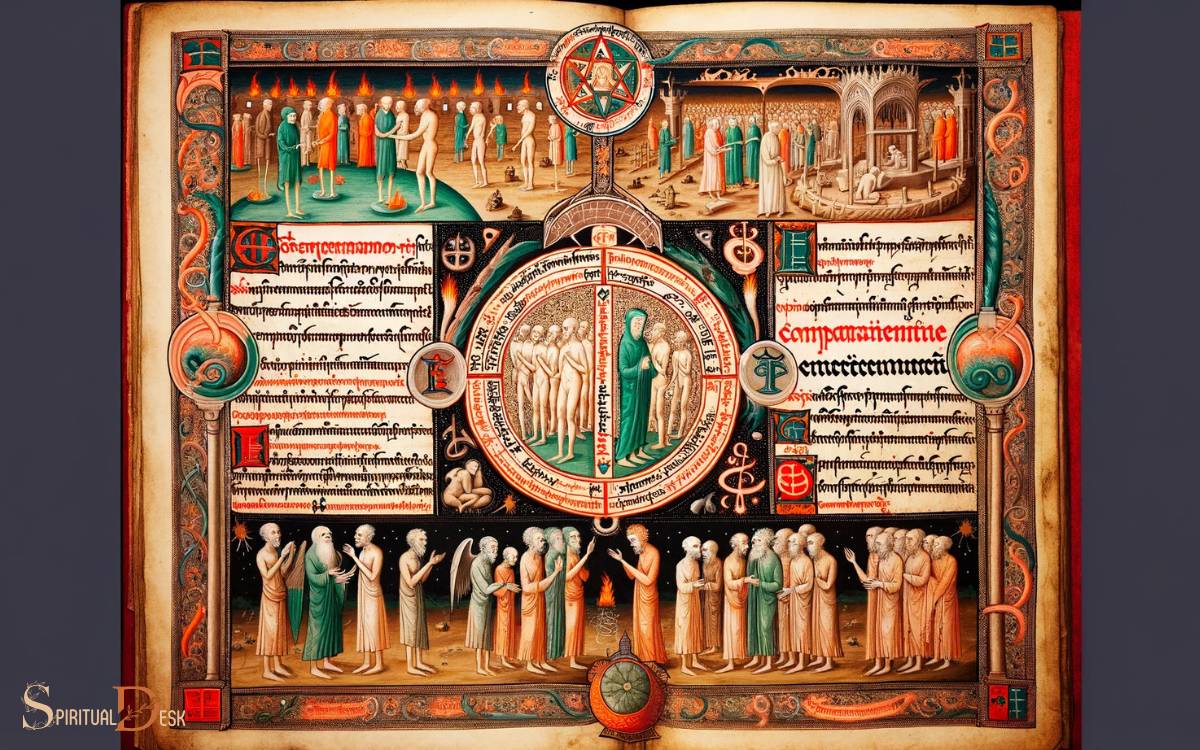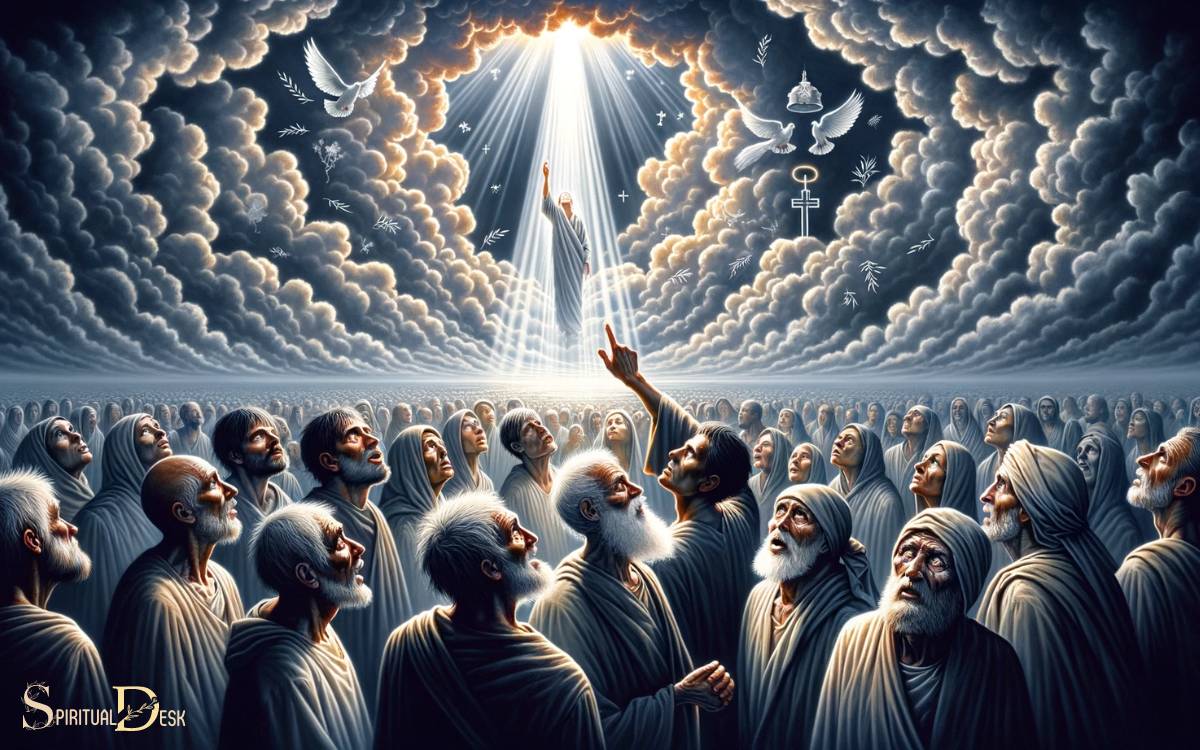What Is the Spiritual Meaning About the 4 Lepers? Faith!
The spiritual meaning of the 4 lepers in the Bible centers around God’s ability to use unlikely individuals to demonstrate His power and deliverance.
The story of the 4 lepers is found in 2 Kings 7:3-20, where Israel is under siege by the Syrian army.
The lepers, considered outcasts and unclean, decide to approach the enemy camp in hopes of survival.
Miraculously, they find the camp deserted because God had caused the Syrians to hear the sounds of a great army, driving them away in fear.
The lepers then inform the Israelites of the abandoned camp, leading to the end of the siege and the saving of their people.
In the story of the 4 lepers, we witness the incredible grace and power of God, who can utilize the most unlikely individuals to bring about His will.
Their humble decision to approach the enemy camp demonstrates that even in the face of desperate circumstances, God is still present and able to provide hope, deliverance, and even miracles.

Key Takeaway
5 Aspects: Spiritual Meaning About the 4 Lepers
| Aspect | Spiritual Meaning of the 4 Lepers |
|---|---|
| Identity | The 4 lepers in the Bible can symbolize the outcasts or marginalized people in society. They can represent those who are deemed as unworthy or unclean by society’s standards. |
| Transformation | The story of the 4 lepers teaches a lesson about the transformative power of faith and trust in God. By stepping out in faith and taking action, the lepers experienced blessings and transformation that they could not have imagined. |
| Divine Intervention | The 4 lepers were used by God to deliver a message of hope and salvation to the people of Israel during a time of famine. Their discovery of the abandoned Syrian camp can be seen as an act of divine intervention and a reminder that God works in mysterious ways. |
| Redemption | The story of the 4 lepers can be seen as a reminder that even the most marginalized individuals can experience redemption and play a significant role in God’s plan. Their actions ultimately led to the salvation of Israel from the ongoing famine. |
| Faith and Trust | The 4 lepers demonstrated faith and trust in God by taking a risk and venturing into the enemy’s camp. This act of faith exemplifies the importance of trusting God’s plan, even in the most desperate situations. |
The Story Unveiled

In the biblical narrative, four lepers, positioned at the outskirts of Samaria’s siege, make a pivotal decision that reveals a profound spiritual lesson.
Facing certain death from starvation or at the hands of their enemies, they choose to venture into the Syrian camp, discovering it deserted and laden with provisions.
This act of desperation turns into divine proof, highlighting themes of faith, courage, and redemption.
You’re invited to ponder the significance of their decision to act despite their dire circumstances. It’s a proof to the unexpected ways in which salvation can manifest.
Their story serves as a metaphor for spiritual awakening, emphasizing that hope and deliverance often arrive when you’re willing to take risks and step into the unknown.
Three Facts About Spiritual Meaning Of the 4 Lepers
Leprosy: A Symbolic Ailment

Leprosy, often depicted in biblical narratives, symbolizes much more than a mere physical ailment, reflecting profound spiritual and societal implications.
This condition serves as a potent metaphor within scripture and theological discourse, offering layers of meaning that extend beyond its medical diagnosis.
- Leprosy represents spiritual corruption, indicating a deeper malaise within the soul.
- It highlights the theme of purification, suggesting a journey towards spiritual cleanliness.
- The ailment signifies isolation, portraying the severance of afflicted individuals from their communities.
- It embodies divine judgment or punishment, a reflection of divine will or displeasure.
- Finally, leprosy can symbolize transformation, marking a pivotal point for renewal or change.
These symbolic interpretations invite a nuanced examination of leprosy, encouraging a deeper understanding beyond its physical manifestations.
Marginalization and Society

You observe that lepers, as social outcasts, represent a profound instance of marginalization in society.
This narrative prompts you to contemplate the dynamics between compassion and exclusion, challenging you to reflect on how societal barriers are both constructed and overcome.
Through this lens, you can explore the broader implications of marginalization on individuals and communities alike.
Lepers: Social Outcasts
Historically, society has marginalized lepers, viewing them as untouchables and relegating them to the fringes of communities.
This approach stems from a combination of fear, misunderstanding, and the visible impact of the disease.
- Fear of contagion led to social isolation.
- Misunderstandings about the disease’s nature fueled superstitions.
- Visible physical effects heightened stigma.
- Lack of medical knowledge perpetuated exclusion.
- Social structures enforced separation, often legally.
This systematic marginalization reflects broader themes of how societies deal with illness and difference.
It underscores the importance of compassion, knowledge, and inclusivity in addressing not just leprosy, but all forms of social exclusion.
Understanding this context is crucial for grasping the full spiritual significance of the story of the four lepers.
Compassion Versus Exclusion

Throughout history, societies have oscillated between compassion and exclusion when confronting the challenges posed by marginalization.
This dynamic plays a vital role in how marginalized groups, like lepers in historical contexts, experience their environment.
You’ll find that compassion often emerges from a deeper understanding and empathy towards those who are sidelined. It’s about recognizing their humanity and extending support, which can greatly impact their social integration and well-being.
On the flip side, exclusion stems from fear, misunderstanding, or stereotypes, leading to the isolation and stigmatization of these individuals.
Such actions not only deprive them of community and resources but also reinforce societal barriers.
The balance between compassion and exclusion reflects broader societal values and the willingness to embrace diversity and inclusion.
Overcoming Societal Barriers
Overcoming societal barriers necessitates a collective effort to dismantle the structures that perpetuate marginalization and inhibit social integration.
This process involves:
- Recognizing the inherent worth and dignity of every individual, regardless of their societal status.
- Advocating for policies that guarantee equal access to resources and opportunities.
- Cultivating empathy and understanding to bridge the divides created by prejudice and discrimination.
- Encouraging inclusive communities that celebrate diversity rather than shun it.
- Implementing educational programs that challenge stereotypes and promote social cohesion.
Divine Intervention Explored

You’ll observe that divine intervention plays a pivotal role in the narrative of the 4 lepers. Miracles aren’t merely coincidental but deeply interwoven with faith and hope.
The unfolding of these miracles reveals the significance of faith’s role in transcending the physical limitations of marginalized individuals.
This analysis further propels the discussion towards understanding how hope is renewed through divine acts, challenging the conventional perceptions of despair and forsakenness.
Miracles Unveiled
Several instances of divine intervention, including the miraculous tale of the 4 lepers, demonstrate how spiritual forces can dramatically alter human circumstances.
This narrative not only enriches our understanding of spiritual domains but also reveals the profound impact of unseen forces on our lives.
Analyzing this story, you’ll find:
- Unforeseen outcomes arising from faith
- The role of divine will in human desperation
- The transformative power of divine acts on societal perceptions
- Redemption and hope that transcend physical afflictions
- The interplay between divine providence and human action
This exploration provides a deeper insight into how divine intervention can manifest in extraordinary ways, challenging our perceptions and offering new dimensions of hope and redemption, without delving into the specific dynamics of faith’s role in these events.
Faith’s Role

Building on the understanding of divine intervention, it’s important to examine how faith acts as a catalyst in these miraculous events.
In the context of the four lepers, their faith—or perhaps their desperation, which can be a form of faith—propelled them into action. This decision, underpinned by faith, set the stage for divine intervention.
Analyzing this, you see that faith isn’t passive; it’s a dynamic force that interacts with the divine to manifest outcomes that defy logical expectations.
It’s vital to recognize that faith in this scenario isn’t merely belief but an active trust in a higher power’s will, guiding actions that lead to unforeseen, positive consequences.
Therefore, faith’s role is pivotal, acting as both a shield and a catalyst in the journey toward divine intervention.
Hope Renewed
In the narrative of the four lepers, divine intervention emerges as a beacon of hope, illuminating the path to an unexpected deliverance.
This moment profoundly symbolizes how, even in the bleakest situations, a higher power can intervene to renew hope and alter destinies.
To understand this deeper, consider:
- The lepers’ decision to seek help, despite their despair.
- The miraculous timing of their discovery.
- How their actions led to the salvation of their city.
- The symbolism of leprosy as isolation and divine intervention as reconnection.
- The broader message of hope for those facing insurmountable odds.
This analysis reveals the multifaceted ways in which divine intervention can serve as a catalyst for change, offering a renewed sense of hope and possibility.
The Path of Transformation

As you explore the spiritual journey of the four lepers, it becomes evident that their path mirrors a transformative process, shedding light on profound spiritual truths.
This transformation isn’t merely physical; it’s deeply symbolic, representing a metamorphosis of the soul.
Through their journey, you witness an evolution from despair to empowerment, highlighting the potential for renewal in even the most dire circumstances.
This narrative underscores the notion that spiritual transformation often arises from confronting and moving beyond one’s limitations and fears.
It’s a journey of self-discovery, where the lepers, initially marginalized, find a new sense of purpose and identity.
Their story is a powerful allegory for the transformative power of faith, resilience, and the human spirit’s capacity for change.
Lessons in Faith and Doubt

You’ll find that embracing uncertainty is a pivotal first step in the spiritual journey of the four lepers.
Overcoming fear, then, isn’t just about bravery but about the profound realization that faith can lead to transformation.
This narrative illustrates how faith’s transformative power acts as an essential mechanism in steering the complexities of belief and skepticism.
Embracing Uncertainty
Embracing uncertainty requires a profound leap of faith, challenging individuals to confront their deepest doubts with courage and openness.
This journey into the unfamiliar fosters growth, pushing you to explore beliefs and values that define your spiritual path.
The narrative of the four lepers serves as a parable for this exploration, illustrating how uncertainty can lead to transformative experiences.
- Acceptance of the unfamiliar as a constant companion
- Recognition of doubt as a catalyst for spiritual inquiry
- Willingness to step into uncharted territories
- Understanding that uncertainty can coexist with faith
- Realization that spiritual growth often requires traversing through ambiguity
This analytical approach encourages a deeper contemplation of how facing the unfamiliar isn’t just a challenge but a necessary element in the journey of faith and personal development.
Overcoming Fear

Overcoming fear necessitates a thorough exploration into the territories of faith and doubt, challenging you to confront and understand the sources of your trepidation. It’s not merely about dismissing fear but dissecting its roots and implications on your spiritual journey.
You’re tasked with examining the interplay between fear and your faith, recognizing how doubt can either erode or reinforce your beliefs.
This introspective process involves questioning the validity of your fears in the context of your faith’s teachings and experiences.
It’s important to analyze how these fears influence your perception of spirituality and your actions.
By critically evaluating your fears through a faith-informed lens, you’re better equipped to navigate them, fostering a deeper, more resilient faith that acknowledges doubt without being overshadowed by it.
Faith’s Transformative Power
Faith’s transformative power reshapes perspectives, revealing that doubt isn’t an adversary but a catalyst for deeper understanding and spiritual growth.
This journey through faith and doubt is evident in the story of the 4 lepers, serving as a profound lesson on the dynamics of belief and skepticism within spiritual contexts.
- Encourages introspection and personal growth
- Highlights the importance of perseverance in the face of uncertainty
- Demonstrates the role of faith in overcoming seemingly insurmountable obstacles
- Illuminates the path to a more profound spiritual connection and understanding
- Showcases the balance between doubt and conviction as essential elements of a dynamic faith
Analyzing this narrative through these lenses offers valuable insights into the intricate relationship between faith and doubt, guiding individuals in their spiritual journeys.
The Power of Action

How does the narrative of the four lepers in biblical scripture illustrate the transformative power of action in the face of adversity?
The story vividly demonstrates that when you’re faced with seemingly insurmountable challenges, taking action, even when the outcome is uncertain, can lead to unforeseen opportunities and blessings.
The lepers, marginalized and in dire straits, decide to act, which not only changes their own fate but also brings hope to their community.
| Aspect | Insight |
|---|---|
| Decision | Choosing action over despair |
| Risk | Braving potential dangers |
| Outcome | Unexpected provision and salvation |
| Impact | Community’s upliftment |
This account underscores that action, propelled by necessity or faith, can be a powerful catalyst for change, underscoring the belief that movement can forge paths where none seemed to exist.
Unexpected Messengers

Reflecting on the power of action as illustrated by the four lepers, it becomes evident that unexpected individuals, often overlooked by society, can emerge as messengers of hope and transformation.
In this light, their story underscores several key insights:
- Unexpected voices can carry profound truths.
- Marginalization doesn’t preclude one from making significant contributions.
- Courage often arises in the face of dire circumstances.
- The act of sharing crucial information can catalyze change.
- Societal perceptions can shift when the marginalized are heard.
These points highlight the complex interplay between societal exclusion and the potential for marginalized individuals to enact meaningful change. The narrative of the four lepers serves as a powerful reminder of the value and impact of unexpected messengers in our midst.
Grace in Desolation

In the midst of desolation, grace often manifests itself through the most unexpected circumstances, revealing a profound capacity for renewal and hope.
This concept is vividly illustrated through the narrative of the four lepers in spiritual texts, who, despite their dire situation, find themselves at the cusp of a transformative discovery.
Their journey, marked by abandonment and societal exclusion, becomes a powerful statement to the idea that grace isn’t absent in desolation but rather intricately woven within it.
Analyzing their story, you uncover that grace in desolation doesn’t merely act as a beacon of light in darkness but serves as a catalyst for profound change, internally and externally.
It’s a reminder that even in the bleakest circumstances, there exists the potential for significant transformation, guided by grace.
The Ripple Effect of Hope

The story of the four lepers demonstrates how a single spark of hope can create a cascade of change, impacting not just the individuals directly involved but also the wider community.
This narrative underscores the profound power of hope in driving transformation and fostering resilience amidst adversity.
To keep you engaged and deepen your understanding, consider these points:
- Hope’s ability to inspire action in dire circumstances
- The communal ripple effects of individual courage
- The transformative power of optimism in bleak situations
- How hope can bridge divides and unite communities
- The role of faith in sustaining hope and enabling change
Analyzing the journey of the four lepers, we observe that hope isn’t merely a personal comfort but a catalyst for widespread societal renewal.
Reflections on Redemption

You’ll find that redemption plays a significant role in the narrative of the four lepers, serving as a powerful force for personal and collective transformation.
This theme resonates deeply within the story, highlighting the transformative power of grace and forgiveness.
| Aspect of Redemption | Impact on Narrative |
|---|---|
| Personal Transformation | Empowers individuals to overcome adversity |
| Collective Healing | Fosters community reconciliation and unity |
| Spiritual Renewal | Encourages a deeper connection with the divine |
| Societal Change | Prompts societal reflection and reform |
Through this lens, the journey of the four lepers becomes a metaphor for the broader human experience of seeking redemption.
It underscores the potential for renewal and change, regardless of past afflictions or societal standing, offering a profound lesson in hope and the possibility of a new beginning.
Conclusion
In closing, the tale of the four lepers transcends its historical context, offering a mirror to our societal and spiritual landscapes. It’s a reminder that, often, the most profound messages come from the most unexpected messengers.
Through their journey, a beacon of hope and transformation emerges from the shadows of marginalization. Like finding a diamond in the rough, this story illuminates the grace present in desolation and the rippling effects of redemption.
Therefore, it invites a deeper reflection on the intersections of faith, society, and self-transcendence.
FAQ Of What Is The Spiritual Meaning About The 4 Lepers
What Is The Story Of The 4 Lepers In The Bible?
The story of the 4 lepers is found in 2 kings 7:3-16. They were outcasts who were desperate for food and decided to go to the enemy camp of the aramean army.
When they arrived, they found it deserted and filled with food and treasure.
They reported this to the king’s men who were skeptical at first but later found out it was true.
What Is The Spiritual Significance Of The 4 Lepers?
The spiritual significance of the 4 lepers is that god used them to bring about a great miracle.
They were outcasts who were despised by society, yet god chose to use them to bring about salvation to the people of israel who were suffering from famine.
How Can We Apply The Story Of The 4 Lepers To Our Lives?
We can apply the story of the 4 lepers to our lives by realizing that god can use us, no matter what our circumstances may be. We should not let our past or present situations limit us or make us feel inferior.
Instead, we should trust in god’s ability to use us for his purposes and be willing to step out in faith when he calls us to do so.
What Lessons Can We Learn From The Story Of The 4 Lepers?
The story of the 4 lepers teaches us several lessons, including the importance of taking risks and stepping out in faith, the power of god to use anyone for his purposes, the significance of generosity and sharing with others, and the need to rely on god’s provision rather than our own efforts.
It also shows us that god is faithful to his promises and can bring about miracles even in the most desperate situations.






